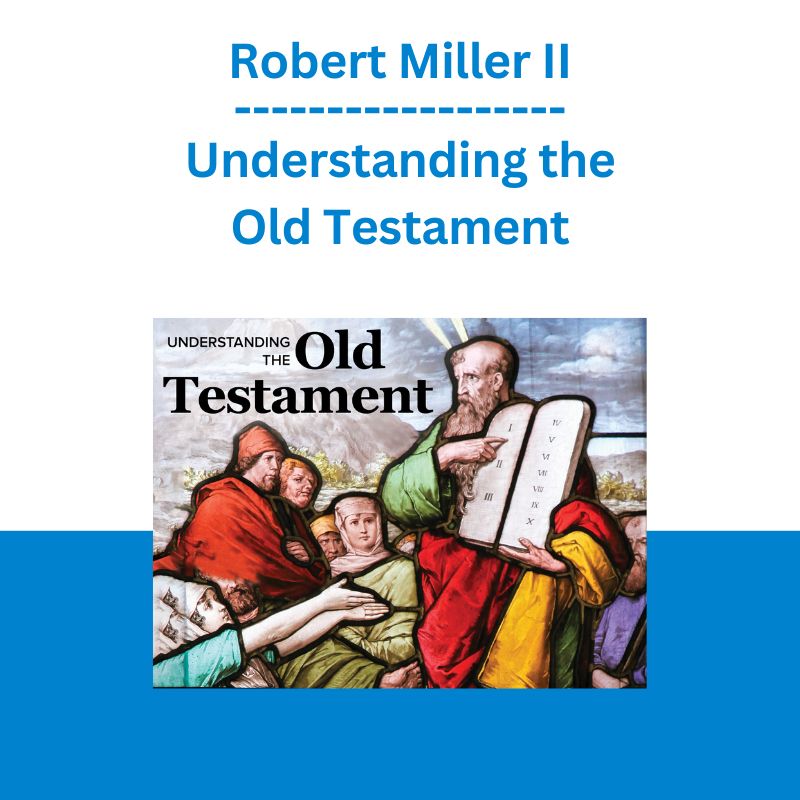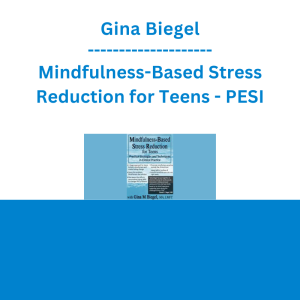*** Proof of Product ***
Exploring the Essential Features of “Robert Miller II – Understanding the Old Testament”
Understanding the Old Testament
Take a fresh and eye-opening look at one of Western civilization’s most fundamental texts and learn to decipher and interpret the meanings of this world-shaping collection of books of the Bible in the Old Testament.
LECTURE (24)
01:The Old Testament as Literature
Consider the historical and literary contexts of the Old Testament, and take an overview of this course. Then, study the events contained within the first six days of creation. For each day, note what was created, how God evaluated it, and how the events of the days are interconnected. Also, observe how the events establish an elaborate pattern and what that pattern meant to ancient Israelites.
02:The Genesis Creation Story
Look at the creation of humanity according to Genesis Chapter 1, and in particular, at how we interpret the idea that humans were made in the image and likeness of God. Then learn about the unique seventh day— the Sabbath—and how the Sabbath was also a day of creation. Investigate the intriguing question of the authorship of the first five books of the Old Testament, known as the Pentateuch or Torah.
03:What God Intended for Adam and Eve
Here, delve into the story of the Garden of Eden. Grasp God’s purpose in creating humans as beings that are both material and spiritual. Consider the significance of the god-like role given to Adam to name other creatures. Learn how woman was created as a counterpart (and even rescuer) of man, and how the creation story accounts for a world that is not what God intended.
04:When Things Go Wrong in the Garden of Eden
In the story of Adam and Eve in the Garden of Eden, explore how ancient Israelites understood the nature of sin. Follow Adam and Eve’s transgression in eating the forbidden fruit and note how this act disrupts both the relationship between the two humans and between humanity and nature. See how the ultimate consequence of the humans’ actions is the loss of fellowship with God.
05:Abraham, the Father of Three Faiths
In a deep look at the figure of Abraham, the spiritual father of three major religions, examine the features of the Covenant made between God and Abraham as Abraham embarks on his legendary journey. Study the three promises God makes, and what God asks of Abraham. Learn about the paradox embodied in God’s command that Abraham sacrifice his son, and what this signifies about the nature of faith.
06:Moses and the Exodus
Read the Call of Moses to liberate the Israelites in Egypt and observe how it resonates with the call of other Biblical prophets. Investigate the Hebrew name of God, Yahweh; how God’s nature is expressed in the name; and why Jews did not speak or write it. Finally, take account of scholarly controversy regarding interpretations of the Ten Plagues and the meaning of the Exodus from Egypt.
07:The Ten Commandments
Consider why the Decalogue, the Ten Commandments, has a significance beyond that of the other 603 commandments in the Torah, and note how the Ten are numbered within different religious traditions. Examine each of the commandments and grasp how these directives by God were intended not to constrain humanity, but to guarantee freedom, of the community and of each individual.
08:The Covenant Code in Exodus
The Covenant Code contains some of the oldest laws of ancient Israel. Read the Code’s many laws, on subjects from religious regulations to social justice, noting that they are considered divine in origin. Compare the Code to the laws of other ancient Near Eastern societies. Learn how, more than legal codes, the laws functioned as moral education regarding notions of human justice.
09:Leviticus at a Crossroads
The book of Leviticus sets out the ways Israelites were to live as God’s people. Delve into three sections of the text, beginning with sacrificial practices. Examine five types of ritual sacrifice and the motives or purposes of each. Investigate the Manual of Impurities, which includes dietary rules on the purity of food. Then learn about the Day of Atonement, the holiest day of the year.
10:Deuteronomy to Kings
Take account of the context of Judges, within the Old Testament books that reveal the story of the Israelites in the Promised Land. Assess different accounts of how the Israelites came to the land of Canaan. Then witness the violent cycle in which they fell into idolatrous behavior, then wound up in enslavement, followed by God sending them a series of charismatic leaders (“judges”) to free them.
11:The Book of Judges
Follow the unfolding narrative of Judges, as the leaders sent to free the Israelites themselves fall from virtue. Study the stories of Gideon and his son, Abimelech, and note archaeological discoveries that show amazing similarities to the biblical story. Conclude with the trials of Jephthah and Samson, and the tragic conclusion of Judges, as Israel descends into immorality and violence.
12:The Books of Samuel
Chart the origins of prophecy in ancient Israel, with prophecy seen during ecstatic, trancelike spiritual practices. Observe how Samuel, the last judge, initiated monarchy among the Israelites, appointing Saul as king. Trace the disastrous reign of David, and the story of Bathsheba. Then meet the wise Solomon, builder of the first temple to Israel’s God, where worship—significantly—focused on a text, not an image.
13:The Books of Kings
Examine the role of the prophet in ancient Israel as the conscience of the nation. Study the life of the prophet Elijah, his actions to affirm the supremacy of God, and his later disillusion and disobedience to God. Grasp Elijah’s role in the fall of the Israelite kingdoms of Israel and Judah to Assyria and Babylon, a story which, nevertheless, ends on a note of hope.
14:Biblical Short Stories: Ruth and Esther
Discover the genre of the biblical short story: Old Testament books that recount single plots, often focusing on displaced women. Learn the story of Ruth, of the land of Moab—Israel’s hated enemy, who survived in Bethlehem through loyalty and resourcefulness. Also, encounter the Jewish, Persian Queen Esther, who saved her people by honoring her Jewishness while being queen of a gentile society.
15:Amos, Prophet of Justice
Explore the preaching of the prophet Amos and his passionate theme of justice for the poor and vulnerable. Note how, as an outsider, Amos brings the northern kingdom of Israel to task for its crimes against the poor, seen in acts such as debt slavery, distortions of justice, and the treatment of concubines. Contemplate Amos’s “three woes” against Israel, and also his concluding vision of hope.
16:The Prophet Isaiah in Three Movements
Examine the three distinct sections of Isaiah: first, the prophet’s stern denunciation of social injustice, and his intimation of a new era of peace under a messianic king; next, a promise of restoration and redemption for Israel, through the figure of the “Suffering Servant”; and finally, the vision of a post-exile Jerusalem, where all peoples are included within the worship of God.
17:Jeremiah, Persecuted Prophet
Within the life and preaching of the prophet Jeremiah, study the book of Jeremiah, Chapter 7, regarding his “temple sermon” preaching against idolatry, injustice, and fraudulent worship. Witness the prophet’s response to his later persecution, and his struggle against his own call to be a prophet. Also read the hopeful prophecy in which God offers a new covenant to Israel, a covenant of forgiveness which will be everlasting.
18:Daniel and Apocalyptic Literature
In approaching the prophetic oracles and stories of the book of Daniel, delve into the genre of Apocalyptic literature—revelation which discloses a transcendent reality. Note the appearance in Daniel of the figure of “the Son of Man,” a divine, human-like being enthroned by God. Study the story of Daniel’s exile to Babylon and take account of its message for diaspora Jews.
19:How Scholars Study Psalms
Uncover the musical nature of the book of Psalms, which were prayers that were originally sung, and how the Psalms embody the words of humans to God. Study the poetic features of the Psalms, highlighting parallelism (correspondence of lines). See how these patterns structure the Psalms and help to decipher meaning. Learn about the titles of the individual Psalms and what they tell us, and how the Psalms fall into five sections or “books.”
20:The Music of the Psalms
In a second look at Psalms, investigate the primary psalm genres—hymns, thanksgivings, and laments— taking account, in each, of who is speaking within a given Psalm and with what intent. Also delve into lesser genres, such as wisdom psalms, pilgrimage songs, and penitential psalms. Discover how psalms are structured, and how these beloved prayers express the gamut of human emotions.
21:Proverbs in the Bible: Wisdom Literature
As context for the book of Proverbs, discover the Old Testament genre of “wisdom literature” and the varieties of knowledge it encompasses. In the first, nine sections of Proverbs, study the use of paired metaphors that guide the reader’s understanding. Examine the use of personification in Proverbs to express wisdom: as referred to as a woman, as present with God at creation, and as equivalent to the nature of the universe.
22:Job’s Suffering and Understanding
Immerse yourself in the mysteries of the book of Job, first identifying its biblical genre and unusual literary structure. Witness God’s wager with the accuser, who questions Job’s faith, and see the unfolding of the guiltless Job’s ensuing tribulations and reckoning with God. Contemplate the many historical explanations of God’s actions, and what the narrative suggests about divine providence and human value.
23:Ecclesiastes and the “Vanity of Vanities”
Grapple with the fascinating and elusive text of the book of Ecclesiastes. In the apparent bleakness of Qohelet’s words, grasp why many through the centuries have found the book depressing. With a careful and rigorous reading, plumb the verses for their deeper meaning: a singular vision of affirmation, reaching beyond the futility of human life to an authentic joy in the gifts of God.
24:Slaying the Dragons of the Old Testament
Conclude by examining a recurrent image within the Old Testament: the figure of the dragon as the personification of evil. Look back through the entire Old Testament at the metaphor of dragon-slaying, at the hands of God, and explore its appearance within earlier mythic traditions. Through multiple textual references, see how this unusual metaphor constitutes an analogy for human suffering and redemption.
DETAILS
Overview
The 39 books of the Old Testament constitute the Hebrew Bible, comprise nearly three quarters of the Christian Bible, and contain substantial material considered sacred within Islam. As such, the Old Testament is among the most influential and widely read texts in world history.
About
Robert D. Miller II
Join me for this fascinating exploration of the old testament; stepping back in time to witness the historical birth of a book that continues to shape our world.
ALMA MATER
University of Michigan
INSTITUTION
The Catholic University of America
Robert D. Miller II is Ordinary Professor of Old Testament at The Catholic University of America. He received a PhD in Biblical and Near Eastern Studies from the University of Michigan. He is a research associate at the University of Pretoria and a life member of St John’s College Cambridge.
Professor Miller is a scholar of the history, literature, religion, and archaeology of ancient Israel. His books Chieftains of the Highland Clans: A History of Israel in the 12th and 11th Centuries BC and Oral Tradition in Ancient Israel, as well as related related articles, made him a recognized authority on early Israel. Other books by him include Covenant and Grace in the Old Testament: Assyrian Propaganda and Israelite Faith and The Dragon, the Mountain, and the Nations: An Old Testament Myth, Its Origins, and Its Afterlives.
Professor Miller has worked in the interface of science and theology as the recipient of two major grants in that area, and he participates in Jewish-Christian and Muslim-Christian dialogue at local and international levels. He is a former member of the board of trustees of the American Schools of Oriental Research and was one of the translators of the New American Bible Revised Edition. In 2015, he received the Teacher of the Year Award from his university’s School of Theology and Religious Studies Student Association.
Please see the full list of alternative group-buy courses available here: https://lunacourse.com/shop/










 Jesse Livermore Trading System - Joe Marwood
Jesse Livermore Trading System - Joe Marwood  Matan Feldman - The 13-Week Cash Flow Modeling - Wall Street Prep
Matan Feldman - The 13-Week Cash Flow Modeling - Wall Street Prep  Atlas API Training - API 570 Exam Prep Training Course
Atlas API Training - API 570 Exam Prep Training Course  Dave Landry - Stock Selection Course
Dave Landry - Stock Selection Course  Julie Stoian & Cathy Olson - Launch Gorgeous - Funnel Gorgeous Bundle
Julie Stoian & Cathy Olson - Launch Gorgeous - Funnel Gorgeous Bundle  Fred Haug - Virtual Wholesaling Simplified
Fred Haug - Virtual Wholesaling Simplified  Gina Biegel - Mindfulness-Based Stress Reduction for Teens - PESI
Gina Biegel - Mindfulness-Based Stress Reduction for Teens - PESI  SMB - Options Training
SMB - Options Training  Forexmentor - Recurring Forex Patterns
Forexmentor - Recurring Forex Patterns  Akil Stokes & Jason Graystone - TierOneTrading - Trading Edge 2019
Akil Stokes & Jason Graystone - TierOneTrading - Trading Edge 2019  Greg Loehr - Advanced Option Trading With Broken Wing Butterflies
Greg Loehr - Advanced Option Trading With Broken Wing Butterflies  Racing Workshop - Complete Online Package
Racing Workshop - Complete Online Package